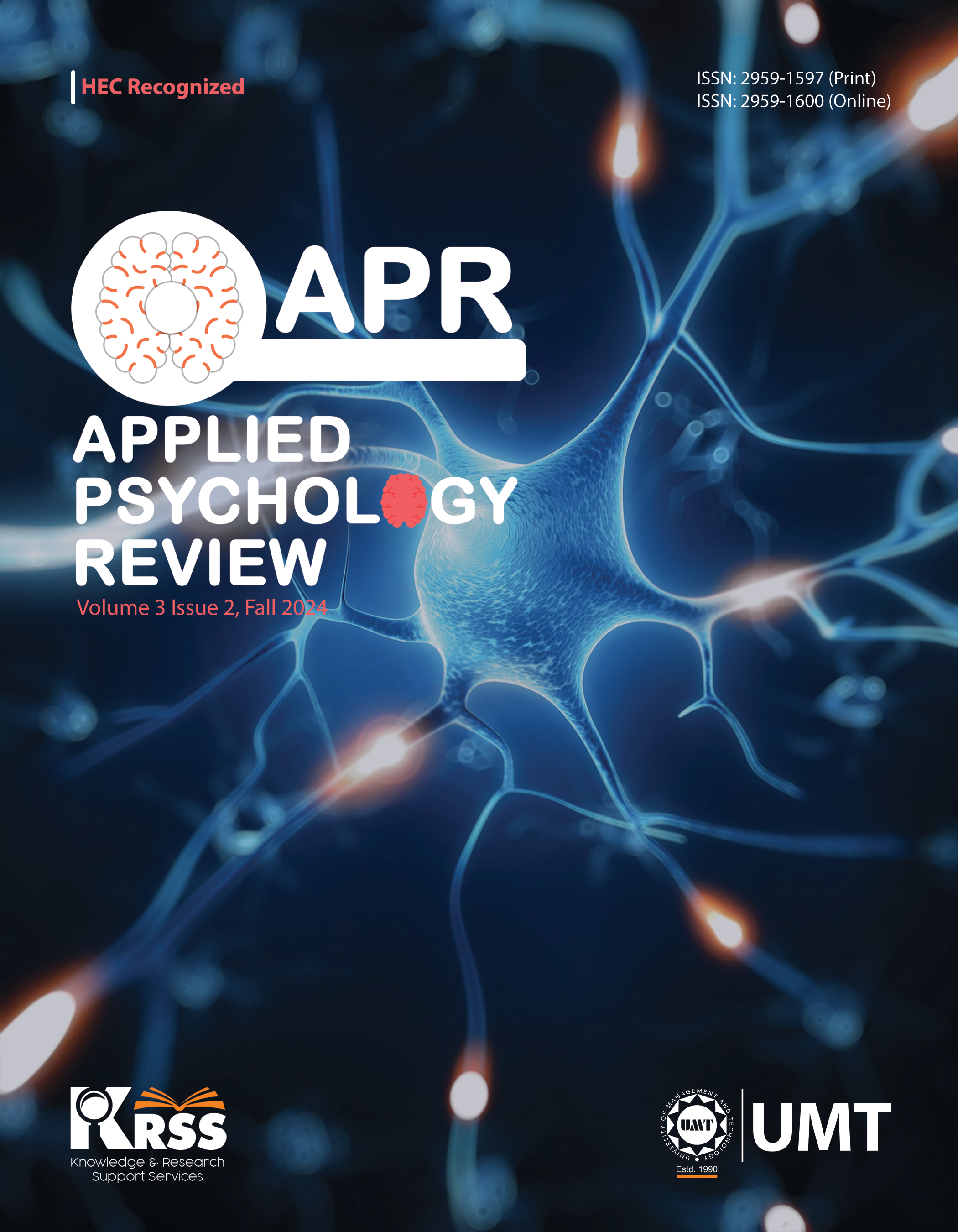Impact of Negative Attribution Style on Non-Suicidal Self-Injurious Behavior among Homeless Individuals
Abstract
 Abstract Views: 0
Abstract Views: 0
Non-suicidal self-injurious behaviors have been examined by researchers for several decades (Klonsky et al., 2016). Negative attribution style is considered as a possible contributing factor in explaining non-suicidal self-injurious behaviors. The current study was carried out to explore the impact of negative attribution style on such behaviors among conveniently selected 300 homeless individuals from Khyber Pakhtunkhwa (KPK). The individuals were approached and briefed about the research and data collection procedure. The participants completed the Attributional Style Questionnaire and Ottawa Self-injury Inventory along with the demographic sheet. Negative attribution style was found to be positively related to non-suicidal self-injurious behaviors. The results revealed that this style positively predicted such behaviors among homeless individuals. Furthermore, it explained 13.1% variation in this type of behavior. Both subcategories of this attribution style positively predicted non-suicidal self-injurious behaviors. The results also revealed that stability explained 15.5% variation, whereas globality explained 9.6% variation in such behaviors. Moreover, the study revealed significant gender-based differences with respect to self-injurious behaviors. Strategies can be developed to target negative attribution styles and to promote positive ones. Psychosocial intervention targeting non-suicidal self-injurious behaviors can be used in this regard.
Downloads
References
Alowaimer, O. (2018). Causes, effects and issues of homeless people. Journal of Socialomics, 7(3), Article e1000223. https://doi.org/10.41 72/2167-0358.1000223
Barrocas, A. L., Giletta, M., Hankin, B. L., Prinstein, M. J., & Abela, J. R. (2015). Non-suicidal self-injury in adolescence: Longitudinal course, trajectories, and intrapersonal predictors. Journal of Abnormal Child Psychology, 43(2), 369–380. https://doi.org/10.1007/s10802-014-9895-4
Boone, S. D., & Brausch, A. M. (2016). Physical activity, exercise motivations, depression, and non-suicidal self‐injury in youth. Suicide and Life‐Threatening Behavior, 46(5), 625–633. https://doi.org/10.1111/sltb.12240
Burton, M. (2014). Self-harm: Working with vulnerable adolescents. Practice Nursing, 25(5), 245–251. https://doi.org/10.12968/pnur.2014.25.5.245
Cohen, B. E., Edmondson, D., & Kronish, I. M. (2015). State of the art review: Depression, stress, anxiety, and cardiovascular disease. American Journal of Hypertension, 28(11), 1295–1302. https://doi.org/10.1093/ajh/hpv047
Dykema, J., Bergbower, K., Doctora, J. D., & Peterson, C. (1996). An attributional style questionnaire for general use. Journal of Psychoeducational Assessment, 14(2), 100–108. https://doi.org/10.1177/073428299601400201
da Silva Bandeira, B. E., Dos Santos Júnior, A., Dalgalarrondo, P., de Azevedo, R. C. S., & Celeri, E. H. V. R. (2022). Nonsuicidal self-injury in undergraduate students: A cross-sectional study and association with suicidal behavior. Psychiatry Research, 318, e114917. https://doi.org/10.1016/j.psychres.2022.114917
Floyd, P. N. (2019). Emotion reactivity, emotion dysregulation, and non-suicidal self-injury among at-risk adolescents: A multiple mediation analysis [Master thesis, The University of Southern Mississippi]. AQUILA. https://aquila.usm.edu/masters_theses/654
Fox, K. R., Millner, A. J., Mukerji, C. E., & Nock, M. K. (2018). Examining the role of sex in self-injurious thoughts and behaviors. Clinical Psychology Review, 66, 3–11. https://doi.org/10.1016/j.cpr.2017.09.009
Frumkin, M. R., Robinaugh, D. J., LeBlanc, N. J., Ahmad, Z., Bui, E., Nock, M. K., Simon, N. M., & McNally, R. J. (2021). The pain of grief: Exploring the concept of psychological pain and its relation to complicated grief, depression, and risk for suicide in bereaved adults. Journal of Clinical Psychology, 77(1), 254–267. https://doi.org/10.1002/jclp.23024
Gleason, K. D., Baker, C. K., & Maynard, A. (2018). Discursive context and language as action: A demonstration using critical discourse analysis to examine discussions about human trafficking in Hawai ‘i. Journal of Community Psychology, 46(3), 293–310. https://doi.org/10.1002/jcop.21940
Goubet, K. E., & Chrysikou, E. G. (2019). Emotion regulation flexibility: Gender differences in context sensitivity and repertoire. Frontiers in Psychology, 10, Article e935. https://doi.org/10.3389/fpsyg.2019.00935/
Hendrick, M. T. (2016). Depression’s connection to self-harming behavior in adolescents [Master thesis, S.T. Johns Fisher University]. Fisher Digital Publication. https://fisherpub.sjf.edu/education_ETD_masters/350/
Klonsky, E. D., Victor, S. E., & Saffer, B. Y. (2014). Non-suicidal self-injury: What we know, and what we need to know. The Canadian Journal of Psychiatry, 59(11), 565–568. https://doi.org/10.1177/070674371405901101
Labelle, R., Breton, J.-J., Pouliot, L., Dufresne, M.-J., & Berthiaume, C. (2013). Cognitive correlates of serious suicidal ideation in a community sample of adolescents. Journal of Affective Disorders, 145(3), 370–377. https://doi.org/10.1016/j.jad.2012.08.027
Lewis, C. A., Davis, S., Sohail, T., & Khawaja, A. O. (2019). Urdu translation of the Ottawa self‐injury inventory version 3.1. Asia‐Pacific Psychiatry, 11(3), Article e12359. https://doi.org/10.1111/appy.12359
Monfort-Escrig, C., & Pena-Garijo, J. (2020). Attributional styles and social functioning in schizophrenia. Is the learned helplessness model suitable? Clinical and Health: Journal of Empirical Research in Psychology, 32(1), 7–14. https://doi.org/10.5093/clysa2020a21
Müller, A., Claes, L., Smits, D., Brähler, E., & de Zwaan, M. (2016). Prevalence and correlates of self-harm in the German general population. PLOS ONE, 11(6), Article e0157928. https://doi.org/10.1371/journal.pone.0157928
O’Connor, R. C. (2011). Towards an integrated motivational-volitional model of suicidal behaviour. In R. C. O’Connor, S. Platt, & J. Gordon (Eds.), International handbook of suicide prevention: Research, policy & practice (pp. 181–198). Wiley-Blackwell. https://doi.org/10.1002/9781119998556.ch11
Pan, J., Liu, B., & Kreps, G. L. (2018). A content analysis of depression-related discourses on Sina Weibo: Attribution, efficacy, and information sources. BMC Public Health, 18(1), 1–10. https://doi.org/10.1186/s12889-018-5701-5
Perry, J., & Craig, T. K. (2015). Homelessness and mental health. Trends in Urology and Men's Health, 6(2), 19–21. https://doi.org/10.1002/tre.445
Pinillo, M. (2021). Precursors and outcomes: A look at mental health in relation to homelessness. Modern Psychological Studies, 26(1), Article e2.
Qu, D., Wen, X., Liu, B., Zhang, X., He, Y., Chen, D., Duan, X., Yu, J., Liu, D., Zhang, X., Ou, J., Zhou, J., Cui, Z., An, J., Wang, Y., Zhou, X., Yuan, T., Tang, J., Yue, W., & Chen, R. (2023). Non-suicidal self-injury in Chinese population: A scoping review of prevalence, method, risk factors and preventive interventions. The Lancet Regional Health–Western Pacific, 37, Article e100794. https://doi.org/10.1016/j.lanwpc.2023.100794
Richards, J., & Kuhn, R. (2023). Unsheltered homelessness and health: A literature review. AJPM Focus, 2(1), Article e100043. https://doi.org/10.1016/j.focus.2022.100043
Robinson, P. M. (2017). Attribution style and depressive symptoms among African American women [Master thesis, Walden University]. ScholarWork. https://scholarworks.waldenu.edu/cgi/viewcontent.cgi?article=4513&context=dissertations
Samari, E., Shahwan, S., Abdin, E., Zhang, Y., Sambasivam, R., Teh, W. L., Ong, S. W. Chong, S. W., & Subramaniam, M. (2020). An exploration of differences between deliberate self-harm with and without suicidal intent amongst a clinical sample of young people in Singapore: A cross-sectional study. International Journal of Environmental Research and Public Health, 17(4), Article e1429. https://doi.org/10.3390/ijerph17041429
Selby, E. A., Anestis, M. D., Bender, T. W., & Joiner, T. E. Jr. (2009). An exploration of the emotional cascade model in borderline personality disorder. Journal of Abnormal Psychology, 118(2), 375–387. https://doi.org/10.1037/a0015711
Zimmermann, M., & Papa, A. (2020). Causal explanations of depression and treatment credibility in adults with untreated depression: Examining attribution theory. Psychology and Psychotherapy: Theory, Research and Practice, 93(3), 537–554. https://doi.org/10.1111/papt.12247
Copyright (c) 2024 Warda Sadiq, Sher Dil

This work is licensed under a Creative Commons Attribution 4.0 International License.




